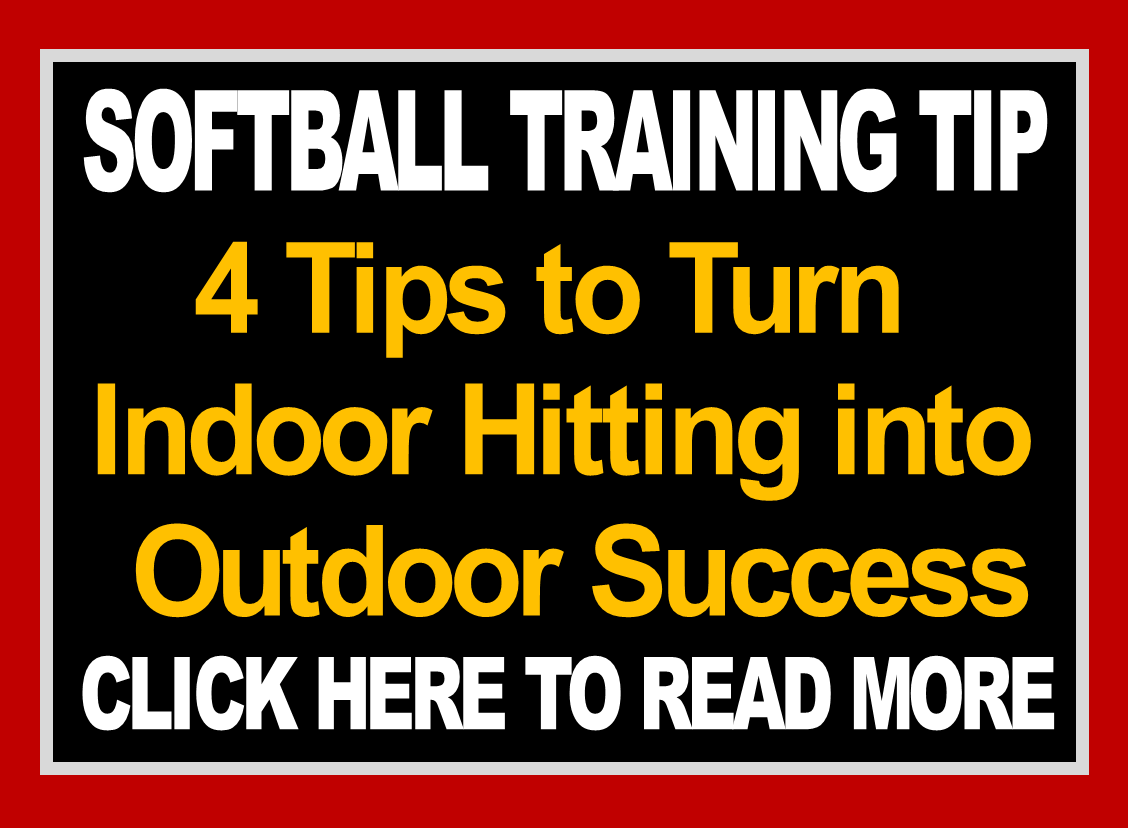
20 Mar 4 Tips to Turn Indoor Hitting into Outdoor Success

Softball season is starting in many parts of the country – inside that is!
Make sure you know the 4 things that will help give your hitters more outside success!
If you’re located in a cold weather climate that probably means you spend a lot of time practicing inside. For anyone who has ever been in that situation you know just how hard it is to go from inside to outside – especially when it comes to fielding flyballs and hitting. Your players will have a hard time picking up the ball because of the change in light and environment. Going from hitting inside, usually in a cage, to hitting outside in the wide open spaces with natural sunlight is a HUGE challenge for our eyes. In order to help our hitters be as successful as possible, as soon as possible we have to somehow help their eyes prepare for that outdoor light, while hitting indoors.
This whole issue first came to my attention when Larissa Anderson was the Associate Head Coach at Hoftstra University (Larissa is now the Head Coach at the University of Missouri). At that time, Larissa sent me an email asking how she could better help her players more successfully hit outside immediately after having hit indoors for so long. Larissa helped me get my brain going in a direction I hadn’t considered before!
Before we check out some possible solutions to this problem let’s first look into how our eyes work in light, and how our brains process what our eyes see. I think it’s some pretty interesting stuff!
How Our Eye’s Handle Light:
- Our eyes have automatic light sensitivity which means that in bright light our eye’s sensitivity drops and we see fine details and bright colors and in dim light our eye’s sensitivity climbs and after a slight adjustment we can see in the dark. All of this happens automatically.
- Our eyes adapt very quickly to bright light but take a longer time to become more sensitive to darkness. That’s why we can’t see anything when we first walk into the dark and why over several minutes we begin to see more. How does all this translate into Softball Hitting– to me, this means that since our indoor lighting is never as bright as it is outdoors, our player’s eyes become overwhelmed when they’re outside, for the first time, and their eyes take in everything missing the important details – like the ball.
How Our Brains Perceive What Our Eyes See:
- Our eyes only see detail from a tiny central spot. We perceive detail by our brains stitching together images as our eyes look around.
- Our eyes don’t send images to our brains. Images are constructed in our brains based on very simple signals sent from our eyes. The mental processing required to perceive images is so great that it represents about 40% of the body’s at-rest caloric consumption. This is why it’s so resting to close our eyes for a moment.
- Our brain recognizes images based on previous patterns. This is something our brains learn as we grow up and continue to see similar patterns.
- This pattern recognition is why motorcyclists and bicyclists get hit every day by people who were looking right at them. Most drivers are looking for cars. If they’re not looking for cyclists, people often won’t even notice them. Drivers can run right into cyclists and never even see them even though the driver was looking right at the bicycle or motorcyclist. If the driver isn’t paying attention, his/her brain won’t perceive the lines and shapes from their eyes as being a motorcycle or a bike.
- And yet, drivers can spot a policeman on a motorcycle a mile away. It’s not just because of the white helmet; it’s because the visual system is working hardest to manage all the inputs it’s receiving and prioritizing how it recognizes things. The brain can only recognize so much, so it’s looking for what concerns it and misses everything else. How does all this translate into Softball Hitting – All this tells me that one of the problems our hitters face when switching from indoors to outdoors is a lack of prioritizing what the brain is seeing (BALL being #1) since it is suddenly seeing so many more things outside than it did inside (like the sky, clouds, trees, space, dirt, grass…)
Even though the lights inside wherever you’re practicing are probably decent, they are nowhere near as powerful as the sun, so whenever your players finally hit outside their eyes are behaving like they’re going from dark into light. This takes an adjustment period that means your players will struggle until their eyes adjust. What we want to do is shorten this adjustment period as much as possible.
With all of that in mind, and remembering that I am not an Ophthalmologist, here are my suggestions for helping your players go from hitting indoors to more successfully adjusting and hitting outdoors:
- I think we can help our players make a faster adjustment with their eyes by brightening up our indoor hitting/fielding environment. I think that getting some portable halogen lights and really brightening the hitting area would really help. These lights are pretty cheap ($45 at your local hardware store) and you can use them near your pitchers, catchers and fielders. These flood lights should start to make your player’s eyes work more like they were outside rather then inside.
- Also, I think painting your hitting area ceiling and walls a Light Blue color or else putting light blue tarps up behind the pitching end of the cage would replicate the outside sky better and help your players eyes adjust quicker to the outside environment. I know this one is pretty random, and might not even be possible for your indoor hitting situation.
- Another suggestion – hit old-fashioned WHITE softballs occasionally, instead of always hitting optic yellow. Again, something to challenge the eyes to more quickly adjust.
- I know that players don’t really know how to use their eyes in a helpful manner, in regards to filtering. Here’s what I mean. Pitchers usually practice in a bullpen of some sort, and whether indoors or outdoors it’s pretty much a library – quiet please and virtually no stimuli. Put that same pitcher in a game – she has the same catcher with the same glove throwing the same ball from the same distance – but the visual stimuli has gone off the charts! There are batters and umpires and fans and cameras (maybe) and on-deck hitters and expectations and blah, blah, blah. It’s not that she suddenly can’t see the catcher or her glove, it’s that she is doing a horrible job of filtering out all the crap! Same goes for our hitters. We have to let our players know that this is normal, and that we can look at all the unimportant stuff when it doesn’t matter – like in the dugout, or even in between swings to help us relax – but then we need to zero in on the important stuff – like the ball – when we’re ready to hit. I really believe that helping our players learn how and when to filter what they see is HUGE in helping them perform successfully under pressure. Any pressurized situation has more crap then usual – whether it’s mental, visual, auditory or even sensory (wind, rain, heat, cold) and we’ve got to learn to filter the crap from the crux! Hitting outside for the first time is nothing if it’s not sensory overload, starting with our eyes but continuing to our ears, our minds and our senses. So overload senses occasionally during indoor hitting practice to help your hitters learn to filter the crap from the crux!



